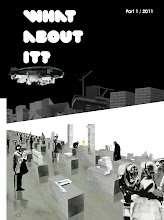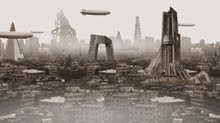
We are all spectators in this peepshow of urban frivolity
By N. Frankowski and C. García
Glamour is the new black. The contemporary city lies as a catwalk for the showcase of the sexy products of fetishistic contemporary Starchitects. Glittering facades, exclusive brand names, flashing lights and slick materials are the Botox and silicone of the glamorous twenty first century urbanism. So what about glamour and the city? Are "we", the designers of the city just a bunch of mere cosmeticians?
As Luis Fernandez Galliano wrote in a soul tearing note about “Losing Faith in Architecture”, the dramatic spectacle orchestrated by the empty-handed and empty-minded in an empty stage was not even able to catch a whisper. But what happens when the collective of that non-sense pretentiousness finds its apocalyptic epitome in a bigger scale? What happens when the aura of the metropolitan is driven by the sensationalistic pleasure of the hedonistic mind? Is the urbanism of the twenty first century like a distorted apotheosis of Koolhaas' City of the Captive Globe? Has the city finally turned into the capital of ego? Is its neatness and its fashionable offerings nothing more than nice looks cast over a lack of substance that hides behind the cosmetics?
In an orgy of desire, the contemporary city exists as a mixture of well branded marketing and eye candy pleasures. Magazine covers, TV shows, Music Videos and Movie Sets highlight that the city is finally a superstar in its own. Beijing, Dubai, and even Lagos are brand names like Paris, Bogotá, London and Manhattan; the taste of the month in the centerfold image. The job of the urbanist has become more and more infatuated by the visual pleasures of Photoshop and by the flash of the cameras. Architecture is a Rock Star, the City its red carpet.
In order to understand the city we must update our jargon; glorify our lexicon. A new terminology has to be applied to describe the glamour that has taken over the city like Plastic Surgery over a model's face. The wrinkles of age are being photoshopped in the name of vanity. Glamour transcends the city; it obliterates it. It transforms the city from a summation of randomness, to a pre-programmed living rendering. The urban dictionary must therefore be reinvented. In constant revision, never serious, these new concepts portray the zeitgeist of the modern grozsdtadt.
Bling Bling Urbanism- Eye candy is applied on a one to one thousand scale. Removing all the layers of human evidence, Bling Bling urbanism shows the surrealist alternative of a non-existent reality. Like the paintings in a museum, the world is turned into an image, and all we can do is to view the forms drawn by the hand of the omnipotent architect/urbanist. We have been doing lèche vitrine on windows filled with empty urban promises. Graphically efficient we lie to ourselves in order to lie to everybody. Too far from eyesight, glamour is being shaped for the city. From the palm shapes of man made islands, to the orthogonal, obtuse and acute angles, and organic forms that are cad-drawn and photoshopped over Google earth images of toy sized cities. Bling Bling urbanism dazzles the spectator.
Sexy Shapes- Previously used exclusively to describe attributes that provoked sexual stimulus; “sexy” is no longer attached to the human figure. As icons are being molded with lust and desire, sexy man-made machines are being raised. Whoever holds the tallest sexiest tower becomes the most virile, thus glamorous of all. It's the perfect mathematical formula: the more it twists, bends, or spread wide open, the most exposure it receives. In this world of paraphernalia, sexy describes it the best, and is being commonly used in magazines, public presentations, and even in the most sacred events in school. Like an adrenaline rush, lust anesthetizes our logic as we become unable to distinguish the obvious lack of content behind the shapes. Unable to identify the repeated plot we fall in the scheme like a lover about to be laid. The scene has been set: a flock of birds flying through a sun irradiated, clean, happy sky; the joyous effect of summer lapped by a gentle wafting fog, and in the background, sexy shapes are erected…
Bimbo Towers- Like the supermodel, high rise is getting primetime broadcast. In a frivolous race for coverage, clients are pouring a lot of time, architects and money to erect towers that, like bimbo girls, look amazing but are empty inside. The skyscraper is, indeed, the final, definitive typology. It has swallowed everything else; its big throat spells the epitaph of what used to be variety and heterogeneity. Aiming for the sky, the new race is on; again, and like Yona Friedman's mobile architecture, it grows equally over a desert, a rice field or a gentrified ex-slum. Sooner than expected, glamour will take over and every city will raise its bimbo tower.
Sassy facades- Distinctively stylish, these pretty faces create boulevards reminiscing boutiques of exclusive clothing. A surgical approach that operates over the urban epidermis, a collective of nicely done facades to decorate our urban experience. Libraries, churches, shopping malls, restaurants and banks are submersed into a bacchanal of urban frivolity. Looking sassy and glamorous, every client hires a nice cosmetician to blur its capitalist intentions with good looks in this tell-me-who-you-hire-as-an-architect-and-I’ll-tell-you-who-you-are parade.
Chic Interiors- The most intimate and perhaps exclusive part of the glamour scheme. The interiors seduce, but don’t satisfy. Identity is dropped intentionally in order to gain credibility in the name of design. You are not longer able to identify the function of the place (or the purpose of it). All neon lit, chic interiors suggest you are in a hotel lobby. At the same time you could be waiting for food, for a shoe, for a book or an airplane. Typology is transfigured into ambience and environment. While not exposed to the outside, it is a direct contributor; an extension of it. The interiors don’t clarify their functions in the city, instead they blur them. Contradiction is its fuel, and while it creates an eternal flow of first-level visitors, could be nothing but a fifth category in the urban meme lexicon; lacking substance and just trying to be glamorous.
Blinded by the glitter and exclusive features of architecture, the neatness of man-made forms and the manifestation of the architects' interpretation of the will of the powerful, the city is about to be dead (again). With an excess of frivolity we have condemned the city to be a little miss sunshine in a beauty pageant, without noticing that its about to become an anorexic model that cannot see itself in the mirror anymore. After modernism, "we" have failed to see ourselves again as urban alchemists. Not because our inability to remember previous Herculean efforts, but because we don’t care anymore. A polished caricature of the city; we have condemned it to be everything we want it to be, not everything it needed to be. Are we about to assume responsibility for the intentionally irresponsible, or are we about to succumb to Al Pacino's favorite sin in his role of a contemporary Mephisto: Vanity. As the world turns, it reveals an instable economy, and uncertain future, it is time for us to wonder what happens when the fireworks are finished and the smoke clears, will the city still be there?■























No comments:
Post a Comment